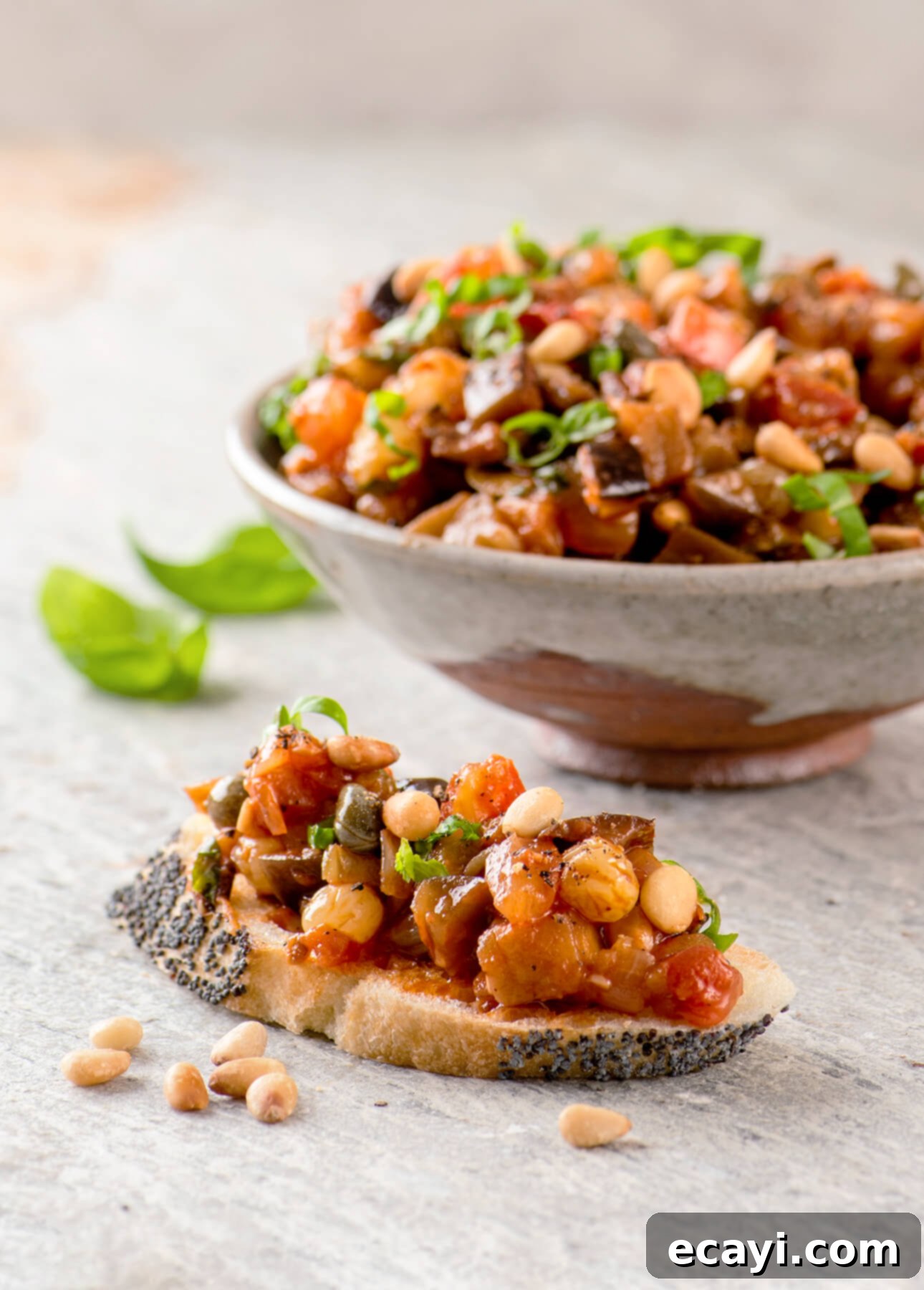Authentic Sicilian Caponata: A Timeless Sweet and Sour Eggplant Masterpiece
Embark on a culinary journey to Sicily with Caponata, an exquisite vegetable dish bursting with vibrant flavors. This aromatic sweet and sour creation, rich in history and tradition, promises a delightful experience. Discover how to craft this iconic Sicilian delicacy and explore its endless serving possibilities.
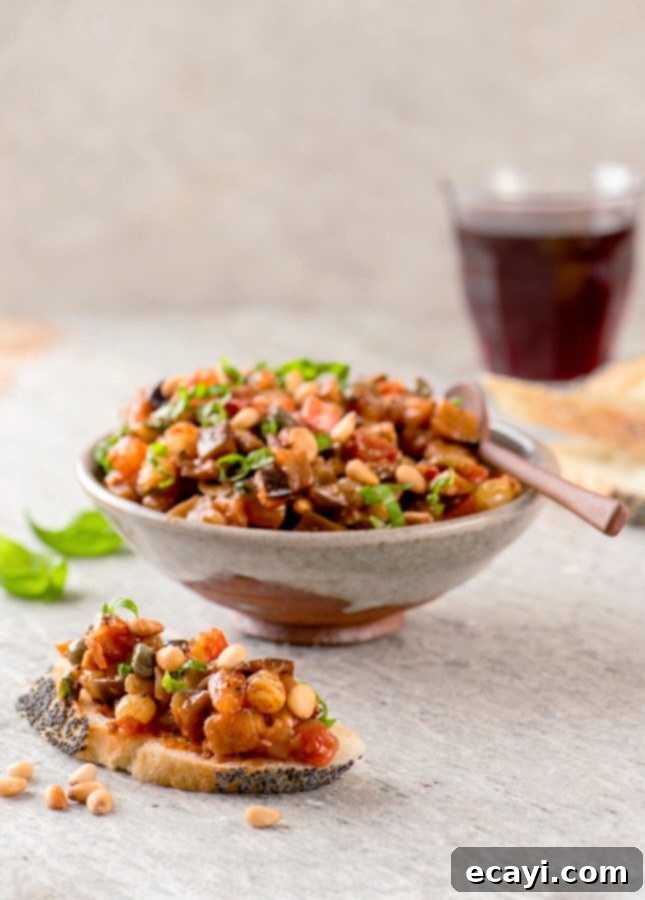
This post contains affiliate links. Full disclosure is at the bottom of the article.
My first encounter with Sicily, a decade ago, was a revelation for the senses, and among its many culinary wonders, caponata stood out immediately. While every dish I savored on that unforgettable trip was magnificent, Sicilian caponata etched itself into my memory as the recipe I was most eager to recreate in my own kitchen. Before tasting this extraordinary dish, I was convinced I didn’t care for eggplant. However, the sublime, creamy, chunky, and perfectly balanced sweet and sour notes of authentic caponata completely transformed my perspective. It wasn’t just a side dish; it was a symphony of flavors that made me fall in love with eggplant.
What Exactly Is Caponata? Unpacking Sicily’s Sweet & Sour Gem
At its heart, caponata is a quintessential Sicilian sweet and sour vegetable stew, often likened to a Mediterranean ratatouille, but with its own distinct personality. This vibrant dish typically features tender eggplant and ripe tomatoes, harmoniously seasoned with ingredients like crisp celery, plump raisins, briny olives, and pungent capers. The genius of caponata lies in its masterful blend of opposing flavors, creating what Sicilians call agrodolce – a traditional Italian sweet and sour sauce that defines many of the island’s most beloved dishes. Achieving the perfect agrodolce balance is crucial: in Sicilian Caponata, the subtle sweetness is primarily derived from the raisins and a touch of sugar, while the invigorating sourness comes from the vinegar, capers, olives, and, intriguingly, a hint of cocoa powder.
Yes, cocoa powder might sound unconventional, but rest assured, it plays an essential, albeit subtle, role in caponata without making the dish taste like chocolate. Instead, a small teaspoon of sifted dark cocoa powder deepens the overall flavor profile, lending an intriguing earthy aroma and a beautiful richness that elevates the dish. This ancient technique harks back to historical Sicilian cooking, where cocoa was used as a spice to add complexity rather than sweetness.
The star ingredient, eggplant, is meticulously diced and then fried in olive oil. This crucial step not only concentrates the eggplant’s flavor but also imbues it with that signature lovely, creamy texture that defines great caponata. When selecting eggplants, smaller varieties are often preferred for their sweeter flavor and thinner skin, which melts seamlessly into the dish. However, if, like me, you primarily find larger, deep purple eggplants, they work perfectly well. The trick is to dice them finely and fry them properly in batches, ensuring they achieve a golden-brown exterior and a tender interior, guaranteeing an equally enjoyable flavor and texture in your caponata.
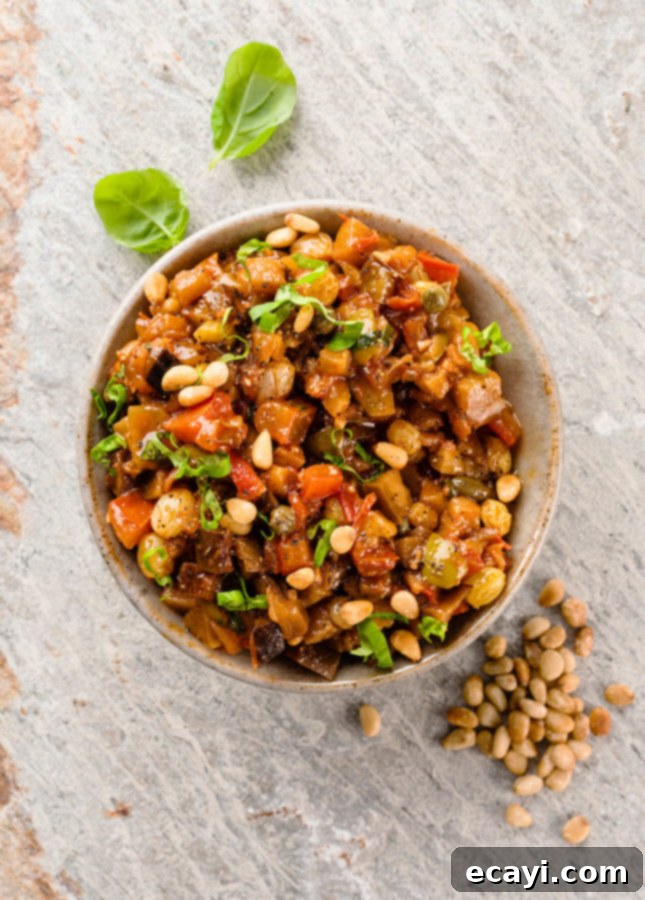
Creative Ways to Serve Sicilian Caponata
Caponata’s versatility is one of its most appealing qualities. In Sicily, I experienced caponata garnished with finely chopped octopus, transforming it into a heartier, more luxurious main course. In Palermo, Sicily’s capital, serving caponata with octopus is a time-honored tradition. Legend has it that centuries ago, this dish was originally prepared for royalty, featuring a prized fish called “capone” (hence the name “caponata”). As it transitioned to a dish enjoyed by the common people, the expensive fish was replaced with more accessible and equally delicious eggplant.
Beyond octopus, the topping possibilities are vast and inviting. You can enhance your caponata with chopped hard-boiled eggs for a simple yet satisfying protein boost, add briny sardines, succulent grilled shrimp, or even luxurious lobster. It also makes a fantastic accompaniment to grilled fish, chicken, or lamb. However, its most classic presentation is served cold or at room temperature as an antipasto – a delightful appetizer – artfully piled onto slices of crusty grilled bread or bruschetta.
A key secret to truly exceptional Sicilian caponata is patience. The flavors develop and deepen significantly as it rests, making it truly shine after at least one day in the refrigerator. This allows the sweet, sour, savory, and earthy notes to meld into a harmonious symphony. After resting overnight, the caponata achieves a thick, rich, and wonderfully creamy consistency, similar to a savory chutney. The good news is that its flavor only improves with age, and you can easily keep caponata refrigerated in an airtight container for up to a week, making it an excellent meal prep option.
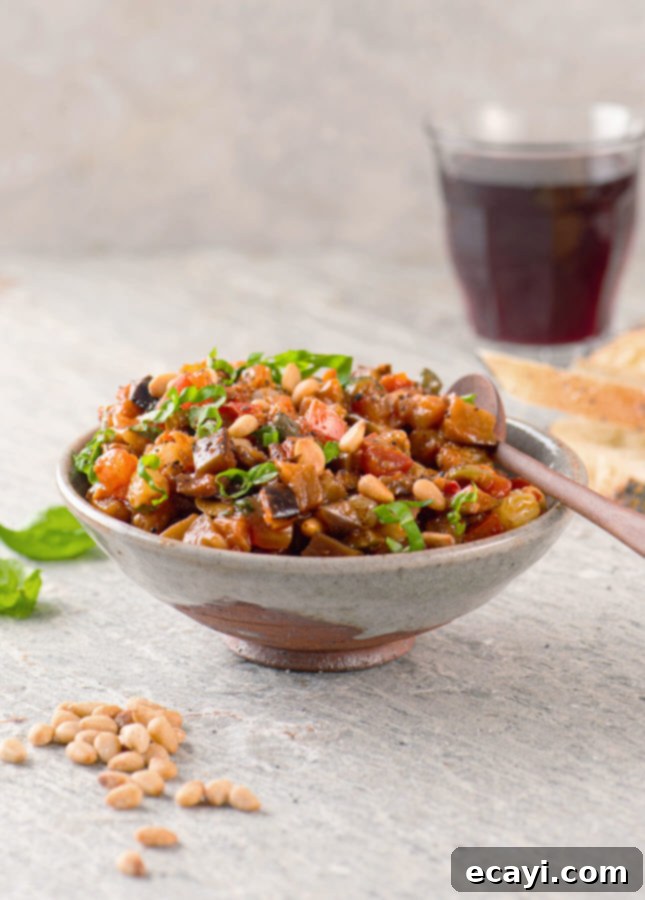
Essential Tips for Crafting Perfect Sicilian Caponata
- Precision in Chopping for Perfect Texture: While Sicilian Caponata is celebrated for its rustic, textured charm, taking the time to chop all your vegetables, especially the eggplant, into even, small dice—ideally around ½-inch (1.25 cm) in size—is paramount. This meticulous preparation ensures that every ingredient cooks uniformly and that the resulting vegetable bits are comparable in size to the olives, raisins, and capers. The outcome is a caponata with an incredibly satisfying mouthfeel where all flavors and textures blend seamlessly.
- Enjoy Caponata Plain or Dressed to Impress: A well-rested caponata is simply magnificent on its own. However, when serving it as an appetizer or for a special occasion, consider elevating its presentation and flavor. A generous drizzle of high-quality extra-virgin olive oil, a sprinkle of freshly chopped herbs (like basil or parsley), and a scattering of additional toasted pine nuts can truly make it sing. For an authentic Sicilian touch, incorporate toppings like chopped hard-boiled eggs, a few sardines, grilled shrimp, or even luxurious chunks of lobster or octopus.
- The Art of Frying Eggplant: Frying the eggplant correctly is perhaps the most critical step. Do not overcrowd your pan; fry the eggplant in batches, ensuring each piece has enough space to brown evenly. Use a high-quality olive oil and make sure it’s hot enough (but not smoking) before adding the eggplant. Fry until golden brown and tender, then transfer to a plate lined with paper towels to drain any excess oil. This prevents the caponata from becoming greasy and ensures a silky texture.
- Balancing the Agrodolce: The hallmark of caponata is its sweet and sour balance. Don’t be afraid to taste and adjust! If your caponata leans too sour, add a pinch more sugar. If it’s too sweet, a splash more vinegar or a few extra capers can balance it out. The goal is a delightful interplay, not dominance, of either flavor.
- Caponata for Any Meal: Beyond its role as a traditional antipasto with toasted croutons or baguette slices, caponata is incredibly versatile. Warm it gently and toss it through pasta for a quick and flavorful vegetarian meal, stir it into creamy risotto, or use it as a vibrant spread for sandwiches and burgers. It’s also an exceptional side dish for grilled fish, roasted chicken, or succulent pork. For an unforgettable brunch, top warm caponata with a perfectly fried egg and serve with toasted country bread.
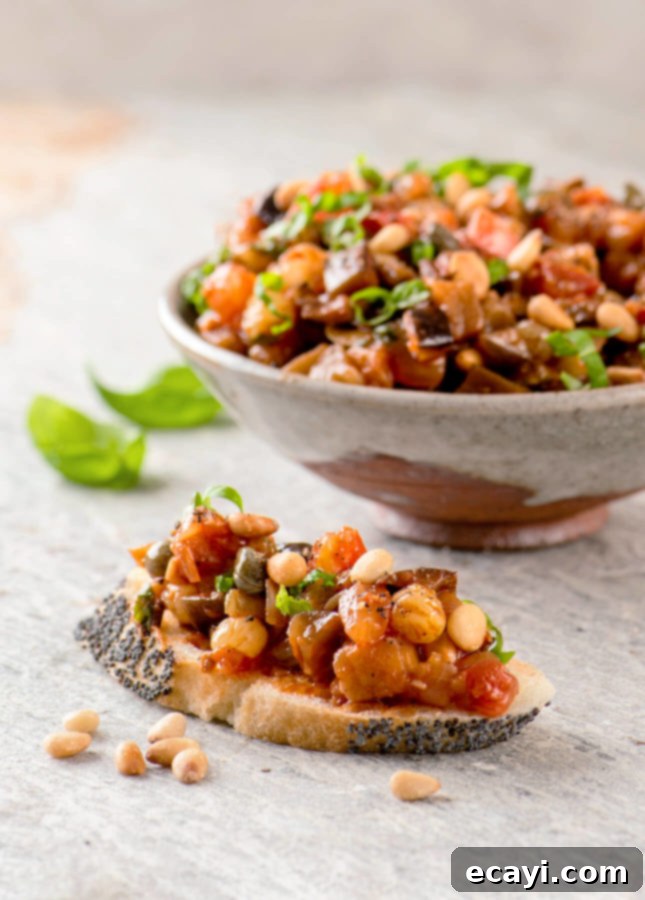
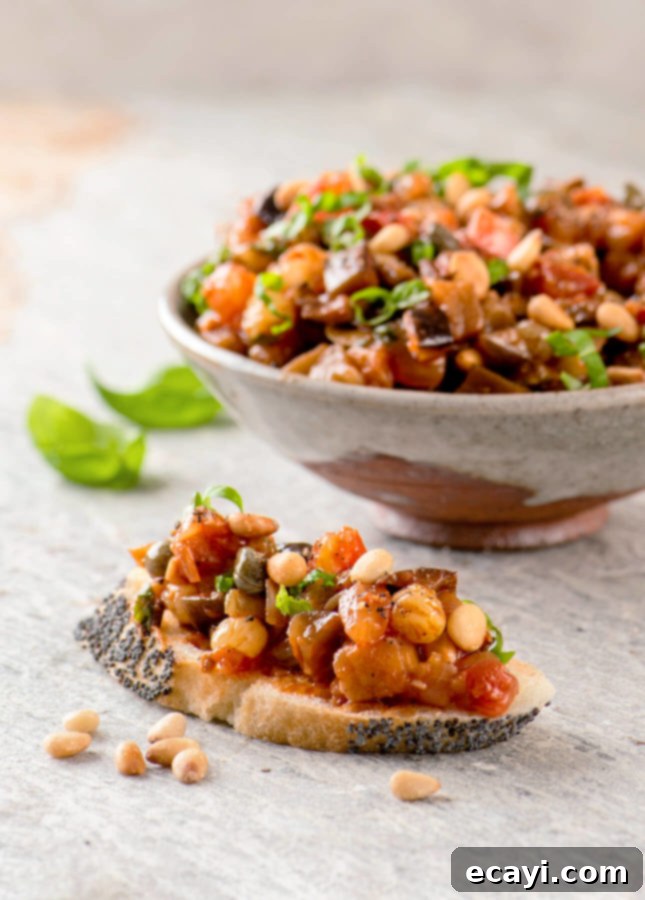
Pin Recipe
Sicilian Caponata
Ingredients
- 1 eggplant of about 1 lb 454 g, cut into 1/2-in (1.25 cm) cubes
- 1/4 cup + 1 tbsp olive oil
- 1 small yellow onion minced
- 1 celery rib diced
- 2 cloves garlic minced
- 1 tsp 5 ml kosher salt, or fine sea salt
- 2 tbsp 30 ml tomato paste whisked into 2 tbsp (30 ml) water
- 3 plum tomatoes seeded and diced
- 1/4 cup 60 ml, packed pitted and chopped green olives
- 1/4 cup 60 ml golden raisins
- 2 tbsp 30 ml capers, rinsed and drained
- 2 tbsp 30 ml white wine vinegar
- 1 tbsp 15 ml sugar
- 1 tsp 5 ml dark cocoa powder (also called Dutch-processed cocoa powder), sifted
- 1/4 cup 60 ml shredded fresh basil
- 2 tbsp 30 ml toasted pine nuts (see note)
- To serve optional
- Toasted pine nuts see note
- Fresh basil or flat-leaf parsley
- Best-quality extra-virgin olive oil
- Flaky sea salt
- Toasted baguette slices
Instructions
-
In a large nonstick saute pan set over high heat, heat 2 tbsp (30 ml) of the olive oil. When the oil is very hot and glistening, fry half the eggplant cubes, tossing occasionally, until browned (about 7 minutes). Transfer to a large plate. Heat 2 tbsp (30 ml) of the remaining olive oil and fry the remaining eggplant cubes. Transfer to the plate with the first batch and reserve.
-
Lower the heat to medium and heat the remaining 1 tbsp (15 ml) olive oil to the same pan. Add the onion and celery and cook, stirring often, until beginning to brown, about 7 minutes. Add the garlic, salt, and pepper, and cook 3 minutes more. Add the tomato paste mixed in water and cook, stirring, until caramelized and almost evaporated, 1 to 2 minutes. Add the diced tomatoes and 1/4 cup (60 ml) water and simmer over low heat for 10 minutes.
-
Stir in the olives, vinegar, raisins, capers, sugar, and cocoa powder and continue cooking, stirring occasionally, for 10 minutes (add 1/4 cup / 60 ml more water if the mixture seems too dry). Incorporate the reserved fried eggplant and cook 5 minutes more, until the caponata is nice and thick. Transfer to a large bowl, add the basil and pine nuts and toss to combine. Taste the Sicilian caponata and adjust the seasoning, if needed. Let cool to room temperature then store in an airtight container in the fridge overnight et let the flavors fully develop.
-
SERVING: Bring Sicilian caponata back to room temperature at least 15 minutes before serving. Garnish with additional pine nuts, chopped herbs, and a drizzle of your best extra-virgin olive oil. Sprinkle with flaky sea salt, if desired. Serve with toasted baguette slices or crackers.
-
STORAGE: Keep Sicilian caponata refrigerated in an airtight container for up to 1 week.
-
NOTE: To toast pine nuts, preheat the oven to 300°F (150°C). Spread the pine nuts over a baking sheet and bake for 5 to 8 minutes, keeping a close eye on them at all times because pine nuts can burn very quickly.
Did you make this?
Tell me how you liked it! Leave a comment or take a picture and tag it with @foodnouveau on Instagram.
Sicilian Caponata is more than just a dish; it’s a celebration of vibrant Mediterranean flavors and a testament to the rich culinary heritage of Italy. Whether you’re a seasoned cook or just beginning your culinary adventures, this recipe promises a rewarding experience and a taste of authentic Sicily. Don’t be shy – try making this sweet and sour eggplant masterpiece at home, let its complex flavors develop, and enjoy it in all the wonderful ways it can be served!
This site is a participant in the Amazon Associates Program, an affiliate advertising program designed to provide a means for the site to earn fees by linking to Amazon and affiliated sites.
If you click on an affiliate link, I may earn advertising or referral fees if you make a purchase through such links, at no extra cost to you. This helps me creating new content for the blog–so thank you! Learn more about advertising on this site by reading my Disclosure Policy.
